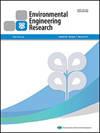Air Quality Index through Inverse Evaluation of Hazard Quotient for Public Indoor Facilities - schools, child daycare centers and elderly nursing homes
IF 3
4区 环境科学与生态学
Q3 ENGINEERING, ENVIRONMENTAL
引用次数: 0
Abstract
Indoor air quality indices (IAQI-S, IAQI-C and IAQI-E) were developed to manage air quality in public facilities for vulnerable groups such as schools, child daycare centers, and elderly nursing homes, respectively. In this study, hazard quotient (HQ) was first designated, then the concentrations of each pollutant were calculated by adding the exposure factor of residents. The presented index was more stringent than comprehensive air quality index (CAI) for outdoor atmosphere. Also, composite indices that integrate individual indices for each pollutant were developed for quick and convenient recognition of the current air quality by administration officers or teachers and to take remedial actions. Among all data collected in field measurements, 75.4%, 71.2% and 35.6% were classified as ‘Good’ or ‘Moderate’ in school classrooms, child daycare centers and elderly nursing homes, respectively基于危害商逆评价的公共室内设施-学校、托儿所和养老院的空气质量指数
室内空气质量指数(IAQI-S、IAQI-C和IAQI-E)分别用于管理学校、儿童日托中心和养老院等弱势群体公共设施的空气质量。在本研究中,首先指定了危害商(HQ),然后通过添加居民的暴露因子来计算每种污染物的浓度。该指标比室外大气综合空气质量指数(CAI)更为严格。此外,还制定了综合指数,将每种污染物的单项指数结合起来,以便行政官员或教师快速方便地了解当前的空气质量,并采取补救措施。在现场测量收集的所有数据中,在学校教室、儿童日托中心和老年疗养院,分别有75.4%、71.2%和35.6%的数据被归类为“良好”或“中等”
本文章由计算机程序翻译,如有差异,请以英文原文为准。
求助全文
约1分钟内获得全文
求助全文
来源期刊

Environmental Engineering Research
Environmental Science-Environmental Engineering
CiteScore
7.50
自引率
5.70%
发文量
80
期刊介绍:
The Environmental Engineering Research (EER) is published quarterly by the Korean Society of Environmental Engineers (KSEE). The EER covers a broad spectrum of the science and technology of air, soil, and water management while emphasizing scientific and engineering solutions to environmental issues encountered in industrialization and urbanization. Particularly, interdisciplinary topics and multi-regional/global impacts (including eco-system and human health) of environmental pollution as well as scientific and engineering aspects of novel technologies are considered favorably. The scope of the Journal includes the following areas, but is not limited to:
1. Atmospheric Environment & Climate Change: Global and local climate change, greenhouse gas control, and air quality modeling.
2. Renewable Energy & Waste Management: Energy recovery from waste, incineration, landfill, and green energy.
3. Environmental Biotechnology & Ecology: Nano-biosensor, environmental genomics, bioenergy, and environmental eco-engineering.
4. Physical & Chemical Technology: Membrane technology and advanced oxidation.
5. Environmental System Engineering: Seawater desalination, ICA (instrument, control, and automation), and water reuse.
6. Environmental Health & Toxicology: Micropollutants, hazardous materials, ecotoxicity, and environmental risk assessment.
 求助内容:
求助内容: 应助结果提醒方式:
应助结果提醒方式:


